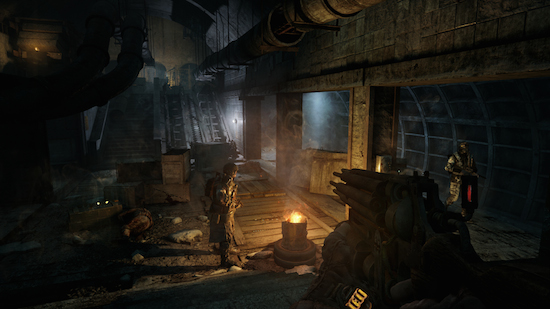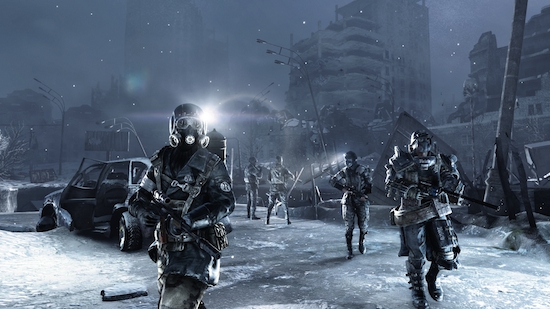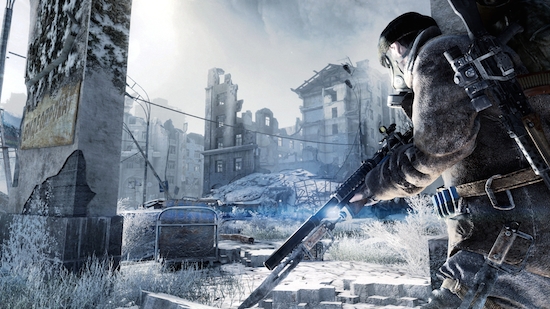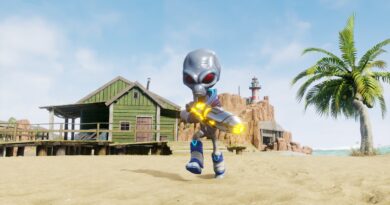Metro Redux, PS4 review
Some people love getting lost underground, in the dark, with makeshift weapons and a limited supply of oxygen. Over to you Guy.
 “Dammit, I’m out of flamethrower fuel. I know from playing the original Metro 2033, that after I reach the missile silo there’s that absolute shite ‘snot bubble level’. Blobs of goo with heat seeking splash damage, that will kill either me or my NPC buddy in a flash. I hate that bit. Right, I’ll swap the flamethrower out for the assault rifle I saw near the old bookshelf in the other room. I’ve got a heap of rounds for it from searching corpses. Five med kits, heap of ammo and some cheap deaths no doubt; that should get me past the snot bubbles of death. Geez I hope it does, I really hate this bit. OK, Captain Miller, let’s go! Wait. What? Why are you going left? I’m sure we go right here….hmm. Crap, here comes the blobs of snot…..insta-death any minute now. No!? Awesome!! 4A games has fixed it. Shoot five snot blobs and I’m clear of this section!? I just cleared the worst part of the original Metro 2033 without even swearing, let alone snapping my controller in half in frustration. Redux rules!”
“Dammit, I’m out of flamethrower fuel. I know from playing the original Metro 2033, that after I reach the missile silo there’s that absolute shite ‘snot bubble level’. Blobs of goo with heat seeking splash damage, that will kill either me or my NPC buddy in a flash. I hate that bit. Right, I’ll swap the flamethrower out for the assault rifle I saw near the old bookshelf in the other room. I’ve got a heap of rounds for it from searching corpses. Five med kits, heap of ammo and some cheap deaths no doubt; that should get me past the snot bubbles of death. Geez I hope it does, I really hate this bit. OK, Captain Miller, let’s go! Wait. What? Why are you going left? I’m sure we go right here….hmm. Crap, here comes the blobs of snot…..insta-death any minute now. No!? Awesome!! 4A games has fixed it. Shoot five snot blobs and I’m clear of this section!? I just cleared the worst part of the original Metro 2033 without even swearing, let alone snapping my controller in half in frustration. Redux rules!”
 I’m a big fan of the Original Metro games so this review has been a real treat. Which on reflection, is actually a bit weird, as few game worlds are this oppressive and melancholy. Metro Redux on PS4, is the spit-shined re-release of Metro: 2033 (2010) and Metro: Last Light + DLCs (2013), the two survival horror, first person shooters from Ukrainian Dev, 4A Games. Both games are now very worthy new gen titles since having a graphical upgrade and now running at a silky 60 frames per second. 4A have also re-tooled the mechanics, bringing the player friendly weapon upgrade and selection system from Last Light, into the now 4 year old, 2033. The stealth system, A.I., lighting and melee systems have also been improved, cleaning up the ‘jank’ Metro 2033 suffered from. Both are now quite beautiful…….. in a post-apocalyptic kinda way.
I’m a big fan of the Original Metro games so this review has been a real treat. Which on reflection, is actually a bit weird, as few game worlds are this oppressive and melancholy. Metro Redux on PS4, is the spit-shined re-release of Metro: 2033 (2010) and Metro: Last Light + DLCs (2013), the two survival horror, first person shooters from Ukrainian Dev, 4A Games. Both games are now very worthy new gen titles since having a graphical upgrade and now running at a silky 60 frames per second. 4A have also re-tooled the mechanics, bringing the player friendly weapon upgrade and selection system from Last Light, into the now 4 year old, 2033. The stealth system, A.I., lighting and melee systems have also been improved, cleaning up the ‘jank’ Metro 2033 suffered from. Both are now quite beautiful…….. in a post-apocalyptic kinda way.
The main protagonist Artyom, silently features in both games with an ongoing mission to save his home station and eventually all the Metro, from things that go bump in the night. Metro: 2033 revolves around the supernatural mutant threat called, “The Dark Ones”. Last Light builds on this further with more characters and the expansion of the Metros fascist political undercurrent narrative, that lay just under the surface in 2033. Throughout both titles, a subliminal question also sits quietly waiting for the player to gradually absorb as the narrative unfolds. Humans have been pushed to the edge of extinction. But considering what has been done in the name of ‘humanity’…..is their stubborn resilience enough to prove they have the right to survive? I’m sure this is no accident, as the strong overarching story and canon comes straight from the source material, the ‘Metro 2033’ Novel, created by Russian author Dmitry Glukhovsky.
 The Metro games have a crafted sense of place and weight. Underground Metro Stations are now villages, where Muscovites have taken refuge from the Nuclear winter on the surface. Here they raise families, trade valuable Military grade ammo (the in-game currency) for goods, and eke out what is a pretty miserable existence through either conflict or co-operation. The tunnels and environments are so well realised, that one could argue that the game world emits the smells and dankness directly into your sub-conscious. You can ‘feel’ the hardship. This was present in the previous generations’ releases, but the solid graphical upgrade has enhanced it no end. 4A Games also took a page out of Valves book and stuck with a constant First Person perspective for the main character, just like Half-Life. Once again, just trying to get players to buy into the world. Walk past children drawing with chalk on the tunnel walls or men at a make shift bar drinking nasty homemade Vodka, Artyom overhears conversations which can be mundane, disturbing or even funny. Unfortunately the voice acting can feel a bit clunky at times and some audio channels seem to become mixed during conversations. Both games suffered in this way last generation and its disappointing this issue wasn’t fixed been fixed.
The Metro games have a crafted sense of place and weight. Underground Metro Stations are now villages, where Muscovites have taken refuge from the Nuclear winter on the surface. Here they raise families, trade valuable Military grade ammo (the in-game currency) for goods, and eke out what is a pretty miserable existence through either conflict or co-operation. The tunnels and environments are so well realised, that one could argue that the game world emits the smells and dankness directly into your sub-conscious. You can ‘feel’ the hardship. This was present in the previous generations’ releases, but the solid graphical upgrade has enhanced it no end. 4A Games also took a page out of Valves book and stuck with a constant First Person perspective for the main character, just like Half-Life. Once again, just trying to get players to buy into the world. Walk past children drawing with chalk on the tunnel walls or men at a make shift bar drinking nasty homemade Vodka, Artyom overhears conversations which can be mundane, disturbing or even funny. Unfortunately the voice acting can feel a bit clunky at times and some audio channels seem to become mixed during conversations. Both games suffered in this way last generation and its disappointing this issue wasn’t fixed been fixed.
The Metro games are unapologetic corridor first person shooters with solid, yet complex mechanics, that once mastered feel very grounded in reality. Reloading animations for example, are detailed and intentionally slower than a Call of Duty, so must be planned for during combat situations. Levels often have a few pathways through them, so exploration is rewarded. There may be ammo or a much needed filter for your gasmask down a dark hallway. If you’re lucky, you may get a jump scare or a glimpse of the Metro ‘world’ which is just existing, whether you see it or not. Here’s an example.
 I found myself all alone on the irradiated surface, snowflakes hitting the glass of my gas mask, moving from cover to cover, hiding from winged monsters overhead. I spotted a broken window. So I left the clear path ahead and jumped into what was now a vacant office building with desks and chairs half buried in snow drifts. Hearing growling of a Nosalis (mutant-wolf-monster-thing that’s the most common enemy on the surface) I raised my home-made shot-gun and rounded the corner. I was about to pull the trigger on the Nosalis, but it wasn’t rushing at me like they usually do. In the glow of my headlamp, I could see movement around the monsters feet. She had pups, or cubs or whatever ya call baby monster-dog-things. She was guarding her nest. I backed away, grabbed a filter off a nearby corpse and went on my merry way back to the main path.
I found myself all alone on the irradiated surface, snowflakes hitting the glass of my gas mask, moving from cover to cover, hiding from winged monsters overhead. I spotted a broken window. So I left the clear path ahead and jumped into what was now a vacant office building with desks and chairs half buried in snow drifts. Hearing growling of a Nosalis (mutant-wolf-monster-thing that’s the most common enemy on the surface) I raised my home-made shot-gun and rounded the corner. I was about to pull the trigger on the Nosalis, but it wasn’t rushing at me like they usually do. In the glow of my headlamp, I could see movement around the monsters feet. She had pups, or cubs or whatever ya call baby monster-dog-things. She was guarding her nest. I backed away, grabbed a filter off a nearby corpse and went on my merry way back to the main path.
As a trial, I reloaded the check-point and blasted the mother and cubs, and with that act of bloodshed, was overrun by Nosalis and burnt through 100 rounds of precious ammo getting out of there alive. Buzz words like, ‘choice’ and ‘depth’ where definitely scribbled on some brain-storming white-board at 4A games during the series development. The ambient sound is haunting and crucial for stealth combat, but as mentioned, it is far from consistent in quality. That said, the background music is simple and reflects the limited resources of the Metro and fits in perfectly. For PS4 players, Remote-Play for the Vita has had no consideration at all and is terrible. Those damn missing R1/L1 buttons on the Vita strike again!
 The star of this game is The Metro system and its atmosphere. Flashes of ghosts in the darkness which giggle or scream then vanish. The silence of the tunnels or a chilling wind on the surface, will explode into gunfire and panic in an instant. The new difficulty options let gamers choose how to play. For example, one could opt to have plenty of ammo and run-n-gun gameplay. Whereas purists can still skulk through a hard survival horror with limited ammo, no HUD, scavenging through bodies and cupboards for essential resources.
The star of this game is The Metro system and its atmosphere. Flashes of ghosts in the darkness which giggle or scream then vanish. The silence of the tunnels or a chilling wind on the surface, will explode into gunfire and panic in an instant. The new difficulty options let gamers choose how to play. For example, one could opt to have plenty of ammo and run-n-gun gameplay. Whereas purists can still skulk through a hard survival horror with limited ammo, no HUD, scavenging through bodies and cupboards for essential resources.
Depending on how you attack the Metro, there is 20-30 hours of first person goodness here. The Redux has addressed every issue I had with the originals. The Metro games are one of the true hidden gems of the last generation and now they are even better. 4A Games have made them prettier, more accessible through clever difficulty modifiers and overall greatly enhanced what is a wonderfully depressing world to be in.



